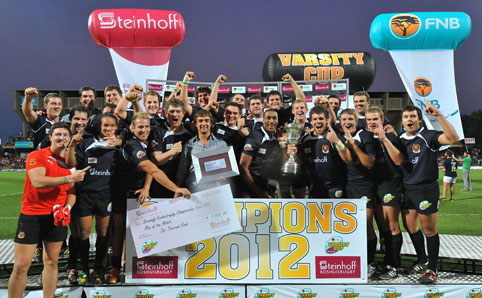 |
|
Photo: Varsity Cup
11 April 2012
|
The best in koshuis rugby. That is the title Vishuis Residence rugby team can use with pride. Vishuis gave Stellenbosch University’s Dagbreek Residence a drubbing with a 44-26 win. They clinched the 2012 Steinhoff Koshuisrugby Championships title on Monday 9 April 2012 at the Tuks Rugby Stadium in Pretoria.
It is the second time that Vishuis has won the tournament. Kovsies now has three Steinhoff Koshuisrugby Championship titles. Armentum won the title in 2009 and Vishuis won its first title in 2010.
Vishuis went into finals unbeaten, whipping residences from the University of Pretoria (Tuks) and Tshwane University of Technology (TUT) on their way to victory. The Kovsie students beat Steinhoff Mopanie from Tuks 26-18 in a round three match and thrashed TUT’s Steinhoff Monitor 133-13 in a round five match. The Vishuis team beat Steinhoff Dagbreek 15-14 in their first match of the tournament. The Kovsies played five matches in total.
Vishuis team manager and fellow-coach, Gerhard Meyer, said it was only the third time that his team had participated in the tournament. Meyer, who played in the Vishuis team that won the tournament in 2010, said winning the Championship as player and fellow-coach was a personal highlight. “Taking it step by step, the hard work of the boys has been rewarded.”